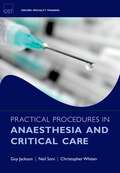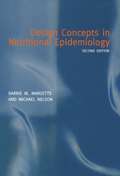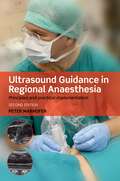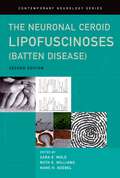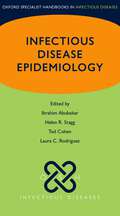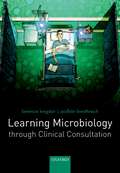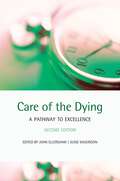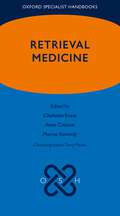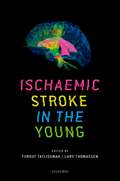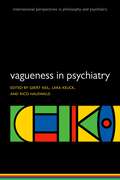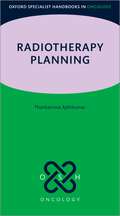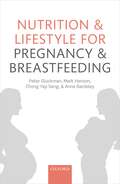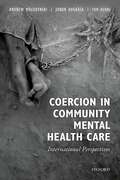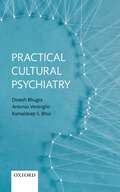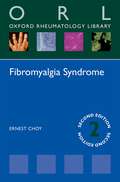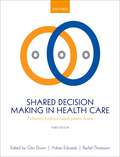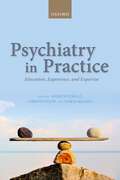- Table View
- List View
Practical Procedures in Anaesthesia and Critical Care (Oxford Specialty Training: Techniques)
by Guy Jackson Neil Soni Christopher J. WhitenThe ability to perform a wide variety of practical procedures safely and competently is essential for any doctor involved in the practice of anaesthesia and intensive care. Junior doctors especially are now called upon to gain competence in many invasive practical procedures in an increasingly short space of time, whilst also understanding the theory behind them. This highly practical book is the only guide needed to the procedures and techniques commonly used in anaesthesia and critical care medicine. Step-by-step, it clearly explains each technique and procedure, enabling the reader to fully understand how and why they are performed. Full colour photographs illustrate each technique, and every chapter covers the same essential information: definition, indications, contraindications, complications, equipment, sites, and technique, for ease of use. This book will be used by all junior trainees in anaesthesia, along with junior doctors from other specialities working in intensive care units. It will also be useful to any senior anaesthetist who wishes to update or refresh their knowledge, as well as anyone working in the emergency ward who performs any of these procedures.
Design Concepts in Nutritional Epidemiology
In examining the relationship between nutritional exposure and disease aetiology, the importance of a carefully considered experimental design cannot be overstated. A sound experimental design involves the formulation of a clear research hypothesis and the identification of appropriate measures of exposure and outcome. It is essential that these variables can be measured with a minimum of error, whilst taking into account the effects of chance and bias, and being aware of the risk of confounding variables. The first edition of Design Concepts in Nutritional Epidemiology presented a throrough guide to research methods in nutritional epidemiology. Since publication of the 1st edition, we now have a much better understanding of the characteristics of nutritional exposure that need to be measured in order to answer questions about diet-disease relationships. The 2nd edition has been extensively revised to include the most up-to-date methods of researching this relationship. Included are new chapters on qualitative and sociological measures, anthropometric measures, gene-nutrient interactions, and cross-sectional studies. Design Concepts in Nutritional Epidemiology will be an essential text for nutritionists and epidemiologists, helping them in their quest to improve the quality of information upon which important public health decisions are made.
Ultrasound Guidance in Regional Anaesthesia: Principles and practical implementation
by Peter MarhoferUltrasonographic guidance for regional anaesthetic blocks is an innovative technique that allows for the direct visualization of nerves, adjacent structures and the position of the needle, as well as for the precise observation of the spread of local anaesthetic. The advantages of the technique allow for the exact administration of moderate volumes of local anaesthetic, reducing the risk of complications. Written by a physician with 16 years' experience in ultrasound-guided regional anaesthesia, this second edition of the well-received practical handbook provides a concise summary of the basics of ultrasound technology and the most recent techniques in the use of ultrasound to guide peripheral nerve blocks, focusing specifically on ultrasound-guided peripheral nerve block techniques. All chapters have been carefully revised to provide the most recent knowledge in the topic of ultrasound in regional anaesthesia. A strong focus has still been attached on anatomical descriptions and subsequent practical implementations. Paediatric applications are now included in this new edition to aid paediatric anaesthesiologists, as well as the incorporation of neuraxial techniques to complete the entire topic. With illustrated colour images throughout, this book is highly relevant to anaesthesiologists and pain specialists with an interest in regional anaesthesia.
The Neuronal Ceroid Lipofuscinoses (Contemporary Neurology Series)
by Sara Mole Ruth Williams Hans GoebelThe neuronal ceroid lipofuscinoses are an extremely rare group of inherited neurodegenerative diseases that primarily affect children. Core symptoms of these conditions typically include epilepsy, cognitive decline and visual failure. These diseases are so rare that professionals who come into contact with them need a consultative reference work that enables them to become expert, or identify who to contact for more details. Fully updated and revised, this second edition continues to be the definitive volume on this devastating group of disorders. Written by an international collection of authorities in the field, it provides invaluable advice on their diagnosis, patient care, and new treatments that are available. This new edition of the definitive reference text on the neuronal ceroid lipofuscinoses will prove useful for clinicians, family physicians, research scientists, diagnostic laboratories, families affected by the disease as well as by workers in industry planning translational research.
Infectious Disease Epidemiology
Infectious Disease Epidemiology is a concise reference guide which provides trainees and practicing epidemiologists with the information that they need to understand the basic concepts necessary for working in this specialist area. Divided into two sections, part one comprehensively covers the basic principles and methods relevant to the study of infectious disease epidemiology. It is organised in order of increasing complexity, ranging from a general introduction to subjects such as mathematical modelling and sero-epidemiology. Part two examines key major infectious diseases that are of global significance. Grouped by their route of transmission for ease of reference, they include diseases that present a particular burden or a high potential for causing mortality. This practical guide will be essential reading for postgraduate students in infectious disease epidemiology, health protection trainees, and practicing epidemiologists.
Infectious Disease Epidemiology
by Ibrahim Abubakar, Helen R. Stagg, Ted Cohen and Laura C. RodriguesInfectious Disease Epidemiology is a concise reference guide which provides trainees and practicing epidemiologists with the information that they need to understand the basic concepts necessary for working in this specialist area. Divided into two sections, part one comprehensively covers the basic principles and methods relevant to the study of infectious disease epidemiology. It is organised in order of increasing complexity, ranging from a general introduction to subjects such as mathematical modelling and sero-epidemiology. Part two examines key major infectious diseases that are of global significance. Grouped by their route of transmission for ease of reference, they include diseases that present a particular burden or a high potential for causing mortality. This practical guide will be essential reading for postgraduate students in infectious disease epidemiology, health protection trainees, and practicing epidemiologists.
Learning Microbiology through Clinical Consultation
by Berenice Langdon Aodhán BreathnachAn understanding of microbiology is essential for both medical students and newly qualified doctors, and is key knowledge for a working doctor. Learning Microbiology through Clinical Consultation introduces the subject with a wealth of life-like case scenarios, each linked with the relevant microbiology. Spanning 14 categories of infection, the cases within the book allow the reader to listen-in on clinical consultations with patients exhibiting an array of symptoms. Each case then describes the examination and the specimen taking techniques. The results of the samples taken in the story provide a clear link to the more technical information on microbiology which is then discussed. The structure of the book is laid out for easy navigation and has clear case-story headings to enable 'just in time learning' between patients, as well as 'just in case learning' when preparing for exams. Learning Microbiology through Clinical Consultation is a highly accessible text that describes the basic science of microbiology within the practice setting in an insightful and informative way. The material is presented in an integrated fashion and is therefore an ideal text for medical students on a systems-based or problem-based course, or for the newly qualified doctor looking to consolidate their knowledge.
Care of the Dying: A pathway to excellence
Even for the most experienced healthcare professional, managing the last few days of life can be difficult. This unique book provides guidelines for the care of the dying based on the Liverpool Integrated Care Pathway for the Dying Patient (LCP). Developed at a hospice, the information can be disseminated and adapted to fit different settings such as hospitals and nursing homes. The LCP is a multiprofessional document that incorporates evidence-based practice and appropriate guidelines related to care of the dying. It provides a template which describes the process of care which is generally delivered in a clinical situation and incorporates the expected outcome of care delivery. The LCP replaces all other documentation in this phase of care. Care pathways can provide a potentially powerful aid to professionals involved in palliative care. Basic principles of treatment are translated into daily practice, including bedside documentation systems, policies and procedures, standards of practice, continuing education and quality improvement programmes. This book also includes chapters on symptom control, ethical issues, communication skills, and spiritual care written by experts in the field which underpin the use of the LCP. Care of the Dying Second Edition will prove invaluable to all healthcare professionals involved in the care of the dying patient, organisations and Trusts who want to develop demonstrable measures and outcomes of care.
Retrieval Medicine (Oxford Specialist Handbooks)
Retrieval Medicine is a core, concise and practical text covering the complex clinical and logistical problems experienced in the retrieval environment. Focusing on evidence-based management and clear clinical guidance, this easily portable handbook provides a comprehensive and accessible guide to this growing field for all health professionals involved in the retrieval and transfer of critically ill patients. Covering the practice of acute, emergency and critical care medicine in the transport environment, this handbook provides the practical guidance and clinical knowledge to enable medical practitioners to function independently in highly variable and resource limited environments with acutely unwell, unstable and often clinically undifferentiated patients over long durations. Closely mapped to the Royal College of Surgeons syllabus on retrieval and transfer medicine, this title comprehensively covers all aspects of retrieval medicine, from basic flight physiology to more complex retrievals and common pitfalls. Authored by an authoritative, international team of expert editors and specialist authors, this clinically focused text is complemented by a range of checklists and reference tools for practical and accessible use in the field. These deliver core information for use in the primary retrieval setting, allowing the retreivalist to structure their approach to a crisis and correct the problem with suggested interventions. Topics include retrieval systems and coordination, crisis resource management, shock, and a range of chapters focusing on responding to specific areas of medicine when encountered in the retrieval environment, such as cardiology and obstetrics and gynaecology.
Retrieval Medicine (Oxford Specialist Handbooks)
by Charlotte Evans, Anne Creaton, Marcus Kennedy and Terry MartinRetrieval Medicine is a core, concise and practical text covering the complex clinical and logistical problems experienced in the retrieval environment. Focusing on evidence-based management and clear clinical guidance, this easily portable handbook provides a comprehensive and accessible guide to this growing field for all health professionals involved in the retrieval and transfer of critically ill patients. Covering the practice of acute, emergency and critical care medicine in the transport environment, this handbook provides the practical guidance and clinical knowledge to enable medical practitioners to function independently in highly variable and resource limited environments with acutely unwell, unstable and often clinically undifferentiated patients over long durations. Closely mapped to the Royal College of Surgeons syllabus on retrieval and transfer medicine, this title comprehensively covers all aspects of retrieval medicine, from basic flight physiology to more complex retrievals and common pitfalls. Authored by an authoritative, international team of expert editors and specialist authors, this clinically focused text is complemented by a range of checklists and reference tools for practical and accessible use in the field. These deliver core information for use in the primary retrieval setting, allowing the retreivalist to structure their approach to a crisis and correct the problem with suggested interventions. Topics include retrieval systems and coordination, crisis resource management, shock, and a range of chapters focusing on responding to specific areas of medicine when encountered in the retrieval environment, such as cardiology and obstetrics and gynaecology.
Ischaemic Stroke in the Young
The incidence of stroke in younger adults is rising, with approximately 5% of all ischaemic strokes occurring in individuals younger than 45 years and 10% occurring in those under 50. Causes and risk factor profiles among young ischaemic stroke patients differ significantly from those in elderly patients, and young patients frequently have genetic or other rare causes which require different diagnostic work-up and treatment strategies from older stroke patients. While the aetiology, diagnosis, and treatment of stroke are commonly covered elsewhere, there is little literature referring specifically to the treatment needs for younger stroke patients. Ischaemic Stroke in the Young brings together the latest research from leading stroke teams, and takes a detailed diagnostic approach to explore the issues particular to younger stroke victims. This problem-based approach complements existing stroke volumes, providing physicians and stroke service staff with the specific diagnostic and treatment information they need when dealing with younger stroke patients.
Ischaemic Stroke in the Young
by Turgut Tatlisumak and Lars ThomassenThe incidence of stroke in younger adults is rising, with approximately 5% of all ischaemic strokes occurring in individuals younger than 45 years and 10% occurring in those under 50. Causes and risk factor profiles among young ischaemic stroke patients differ significantly from those in elderly patients, and young patients frequently have genetic or other rare causes which require different diagnostic work-up and treatment strategies from older stroke patients. While the aetiology, diagnosis, and treatment of stroke are commonly covered elsewhere, there is little literature referring specifically to the treatment needs for younger stroke patients. Ischaemic Stroke in the Young brings together the latest research from leading stroke teams, and takes a detailed diagnostic approach to explore the issues particular to younger stroke victims. This problem-based approach complements existing stroke volumes, providing physicians and stroke service staff with the specific diagnostic and treatment information they need when dealing with younger stroke patients.
Vagueness in Psychiatry (International Perspectives in Philosophy and Psychiatry)
by Geert Keil, Lara Keuck and Rico HauswaldIn psychiatry there is no sharp boundary between the normal and the pathological. Although clear cases abound, it is often indeterminate whether a particular condition does or does not qualify as a mental disorder. For example, definitions of subthreshold disorders and of the prodromal stages of diseases are notoriously contentious. Philosophers and linguists call concepts that lack sharp boundaries, and thus admit of borderline cases, vague. Although blurred boundaries between the normal and the pathological are a recurrent theme in many publications concerned with the classification of mental disorders, systematic approaches that take into account philosophical reflections on vagueness are rare. This book provides interdisciplinary discussions about vagueness in psychiatry by bringing together scholars from psychiatry, psychology, philosophy, history, and law. It draws together various lines of inquiry into the nature of gradations between mental health and disease and discusses the individual and societal consequences of dealing with blurred boundaries in medical practice, forensic psychiatry, and beyond. Part I starts with an overview chapter that helps readers to navigate through the philosophy of vagueness and through the various debates surrounding demarcation problems in the classification and diagnosis of mental illness. Part II encompasses historical and recent philosophical positions on gradualist approaches to health and disease. Part III approaches the vagueness of present psychiatric classification systems and the debates concerning their revision by scrutinizing controversial categories such as post-traumatic stress disorder and by looking into the difficulties of day-to-day diagnostic and therapeutic practice. Part IV finally focuses on social, moral, and legal implications that arise when being mentally ill is a matter of degree.
Radiotherapy Planning (Oxford Specialist Handbooks in Oncology)
by Dr Thankamma AjithkumarRadiotherapy Planning is the new title in the Oxford Specialist Handbooks in Oncology series. It provides a comprehensive guide to modern radiotherapy practice, firmly based on unchanging principles. The author discusses advanced radiotherapy techniques as well as simpler field-based arrangements, so that this handbook can be used globally for clinical practice, including countries with limited resources. The site-specific chapters are structured in two parts. Firstly, current treatment approaches are discussed, with particular attention to the relevant underlying principles to ensure it remains appropriate and useful despite changes in other cancer treatments. The second part of each chapter discusses the most important clinical trials which have informed the current approaches to treatment at the time of publication. In addition, there is a section on imaging features of different tumours, which is useful for clinicians to choose appropriate images for target volume delineation. This handbook will give an accessible introduction to new trainees in the specialty, and it will continue to encourage in all clinical oncologists logical thinking, the ability to ask challenging questions, appropriate analysis of outcomes, and delivery of treatment assessed according to its clinical benefit to patients and its academic rigour.
Nutrition and Lifestyle for Pregnancy and Breastfeeding
by Peter Gluckman Mark Hanson Chong Yap Seng Anne BardsleyExplaining the practical implications of new discoveries in 'life-course biology', Nutrition and Lifestyle for Pregnancy and Breastfeeding is an informed resource on factors that affect offspring development. The impact of parental lifestyle and behavioural choices influence not only fetal development and birth outcomes, but also postnatal development, yet guidance on appropriate diet, behaviour, and exposures during pregnancy is often confusing and contradictory. With accessible explanations of the latest scientific research, and clear summaries and recommendations, this book is a valuable and authoritative guide for all levels of health care providers. The authors provide an overview of the background evidence, highlighting the importance of lifestyle choices prior to and during pregnancy. In-depth discussions of nutritional and lifestyle factors that impact on pregnancy and offspring outcomes are based on the latest research and exploration of key scientific studies. Nutrition and Lifestyle for Pregnancy and Breastfeeding is a manual offering both scientific and clinical evidence to empower health care providers and ensure they have the information necessary to confidently care for prospective and new parents.
Nutrition and Lifestyle for Pregnancy and Breastfeeding
by Peter Gluckman Mark Hanson Chong Yap Seng Anne BardsleyExplaining the practical implications of new discoveries in 'life-course biology', Nutrition and Lifestyle for Pregnancy and Breastfeeding is an informed resource on factors that affect offspring development. The impact of parental lifestyle and behavioural choices influence not only fetal development and birth outcomes, but also postnatal development, yet guidance on appropriate diet, behaviour, and exposures during pregnancy is often confusing and contradictory. With accessible explanations of the latest scientific research, and clear summaries and recommendations, this book is a valuable and authoritative guide for all levels of health care providers. The authors provide an overview of the background evidence, highlighting the importance of lifestyle choices prior to and during pregnancy. In-depth discussions of nutritional and lifestyle factors that impact on pregnancy and offspring outcomes are based on the latest research and exploration of key scientific studies. Nutrition and Lifestyle for Pregnancy and Breastfeeding is a manual offering both scientific and clinical evidence to empower health care providers and ensure they have the information necessary to confidently care for prospective and new parents.
Coercion in Community Mental Health Care: International Perspectives
The use of coercion is one of the defining issues of mental health care. Since the earliest attempts to contain and treat the mentally ill, power imbalances have been evident and a cause of controversy. There has always been a delicate balance between respecting autonomy and ensuring that those who most need treatment and support are provided with it. Coercion in Community Mental Health Care: International Perspectives is an essential guide to the current coercive practices worldwide, both those founded in law and those 'informal' processes whose coerciveness remains contested. It does so from a variety of perspectives, drawing on diverse disciplines such as history, law, sociology, anthropology and medicine to provide a comprehensive summary of the current debates in the field. Edited by leading researchers in the field, Coercion in Community Mental Health Care: International Perspectives provides a unique discussion of this prominent issue in mental health. Divided into five sections covering origins and extent, evidence, experiences, context and international perspectives this is ideal for mental health practitioners, social scientists, ethicists and legal professionals wishing to expand their knowledge of the subject area.
Coercion in Community Mental Health Care: International Perspectives
by Andrew Molodynski, Jorun Rugkåsa and Tom BurnsThe use of coercion is one of the defining issues of mental health care. Since the earliest attempts to contain and treat the mentally ill, power imbalances have been evident and a cause of controversy. There has always been a delicate balance between respecting autonomy and ensuring that those who most need treatment and support are provided with it. Coercion in Community Mental Health Care: International Perspectives is an essential guide to the current coercive practices worldwide, both those founded in law and those 'informal' processes whose coerciveness remains contested. It does so from a variety of perspectives, drawing on diverse disciplines such as history, law, sociology, anthropology and medicine to provide a comprehensive summary of the current debates in the field. Edited by leading researchers in the field, Coercion in Community Mental Health Care: International Perspectives provides a unique discussion of this prominent issue in mental health. Divided into five sections covering origins and extent, evidence, experiences, context and international perspectives this is ideal for mental health practitioners, social scientists, ethicists and legal professionals wishing to expand their knowledge of the subject area.
Practical Cultural Psychiatry
by Dinesh Bhugra Antonio Ventriglio Kamaldeep S. BhuiOver the past decade, cultural psychiatry has become an increasingly important branch of psychiatric research. From the impact of cultural factors on causation, expression, and management of mental health disorders to the development and acceptance of cultural formulation in recent research, it is evident that cultures play a major role in both the genesis and management of psychiatric symptoms. Practical Cultural Psychiatry is a succinct, practical handbook focusing on the clinical impact culture has on mental health disorders worldwide. Covering key topics on migration, racism, self-identity, and social networks, this resource offers practical advice on assessing, investigating, and managing psychiatric conditions. The authors place particular focus on how clinicians can approach patients from different cultural backgrounds than their own to promote pathways to care and patient experience. Written by leading voices in this expanding field, Practical Cultural Psychiatry is a useful tool for all mental health clinicians wishing to improve their approach to multiculturalism and cultural identity in daily practice.
Practical Cultural Psychiatry
by Dinesh Bhugra Kamaldeep S. Bhui Antonio VentriglioOver the past decade, cultural psychiatry has become an increasingly important branch of psychiatric research. From the impact of cultural factors on causation, expression, and management of mental health disorders to the development and acceptance of cultural formulation in recent research, it is evident that cultures play a major role in both the genesis and management of psychiatric symptoms. Practical Cultural Psychiatry is a succinct, practical handbook focusing on the clinical impact culture has on mental health disorders worldwide. Covering key topics on migration, racism, self-identity, and social networks, this resource offers practical advice on assessing, investigating, and managing psychiatric conditions. The authors place particular focus on how clinicians can approach patients from different cultural backgrounds than their own to promote pathways to care and patient experience. Written by leading voices in this expanding field, Practical Cultural Psychiatry is a useful tool for all mental health clinicians wishing to improve their approach to multiculturalism and cultural identity in daily practice.
Fibromyalgia Syndrome (Oxford Rheumatology Library)
by Ernest ChoyPart of the Oxford Rheumatology Library, the second edition of Fibromyalgia Syndrome provides a succinct and practical guide to help rheumatologists and general practitioners diagnose and manage patients with fibromyalgia syndrome. The emphasis throughout is on tailoring treatment to the individual patient, and considering a combination of education, non-pharmacological, and pharmacological treatments. This comprehensive approach improves symptoms and quality of life in all those treated for FMS, benefiting not only patients but also healthcare providers and society. Fibromyalgia syndrome (FMS) afflicts 2-5% of the population, more commonly females than males. It is characterised by chronic widespread pain, although fatigue, sleep disturbance, depression, anxiety, stiffness, and cognitive dysfunction are also common. National and international societies recognise the healthcare burden of FMS, and published recommendations and guidelines emphasise the importance of a positive diagnosis and management strategy to empower patients to cope with FMS. Now updated with new ACR criteria and additional international guidelines on the management of the syndrome, this pocketbook provides the reader with an essential understanding of the pathophysiology of pain in fibromyalgia, the different subtypes of fibromyalgia, and the pitfalls in diagnosis and management of this chronic condition.
Fibromyalgia Syndrome (Oxford Rheumatology Library)
by Ernest ChoyPart of the Oxford Rheumatology Library, the second edition of Fibromyalgia Syndrome provides a succinct and practical guide to help rheumatologists and general practitioners diagnose and manage patients with fibromyalgia syndrome. The emphasis throughout is on tailoring treatment to the individual patient, and considering a combination of education, non-pharmacological, and pharmacological treatments. This comprehensive approach improves symptoms and quality of life in all those treated for FMS, benefiting not only patients but also healthcare providers and society. Fibromyalgia syndrome (FMS) afflicts 2-5% of the population, more commonly females than males. It is characterised by chronic widespread pain, although fatigue, sleep disturbance, depression, anxiety, stiffness, and cognitive dysfunction are also common. National and international societies recognise the healthcare burden of FMS, and published recommendations and guidelines emphasise the importance of a positive diagnosis and management strategy to empower patients to cope with FMS. Now updated with new ACR criteria and additional international guidelines on the management of the syndrome, this pocketbook provides the reader with an essential understanding of the pathophysiology of pain in fibromyalgia, the different subtypes of fibromyalgia, and the pitfalls in diagnosis and management of this chronic condition.
Shared Decision Making in Health Care: Achieving evidence-based patient choice
Over the past decade health care systems around the world have placed increasing importance on the relationship between patient choice and clinical decision-making. In the years since the publication of the second edition of Shared Decision Making in Health Care, there have been significant new developments in the field, most notably in the US where 'Obamacare' puts shared decision making (SDM) at the centre of the 2009 Affordable Care Act. This new edition explores shared decision making by examining, from practical and theoretical perspectives, what should comprise an effective decision-making process. It also looks at the benefits and potential difficulties that arise when patients and clinicians share health care decisions. Written by leading experts from around the world and utilizing high quality evidence, the book provides an up-to-date reference with real-word context to the topics discussed, and in-depth coverage of the practicalities of implementing and teaching SDM. The breadth of information in Shared Decision Making in Health Care makes it an essential resource for policy-makers and health care workers. As health care systems adapt to increasingly collaborative patient-clinician care frameworks, this will also prove a useful guide to SDM for clinicians of all disciplines.
Shared Decision Making in Health Care: Achieving evidence-based patient choice
by Glyn Elwyn, Adrian Edwards and Rachel ThompsonOver the past decade health care systems around the world have placed increasing importance on the relationship between patient choice and clinical decision-making. In the years since the publication of the second edition of Shared Decision Making in Health Care, there have been significant new developments in the field, most notably in the US where 'Obamacare' puts shared decision making (SDM) at the centre of the 2009 Affordable Care Act. This new edition explores shared decision making by examining, from practical and theoretical perspectives, what should comprise an effective decision-making process. It also looks at the benefits and potential difficulties that arise when patients and clinicians share health care decisions. Written by leading experts from around the world and utilizing high quality evidence, the book provides an up-to-date reference with real-word context to the topics discussed, and in-depth coverage of the practicalities of implementing and teaching SDM. The breadth of information in Shared Decision Making in Health Care makes it an essential resource for policy-makers and health care workers. As health care systems adapt to increasingly collaborative patient-clinician care frameworks, this will also prove a useful guide to SDM for clinicians of all disciplines.
Psychiatry in Practice: Education, Experience, and Expertise
Psychiatry in Practice: Education, Experience, and Expertise provides detailed advice and useful tips for early career psychiatrists, and all others who wish to enhance their practical psychiatry skills. Each chapter is written by prominent early career psychiatrists from around the world, offering relevant and timely advice to those who are newly qualified, as well as a global perspective on the practical issues faced today. Covering a variety of topics from 'Psychiatric Emergencies' to 'Ethics and clinical practice in psychiatry', chapters include vignettes of scenarios that may be encountered, making this book pertinent and easily applicable to many early career situations. Skills related to personal management and managing resources are often not taught during training but are key to establishing a career in psychiatry - this book will help the new clinician to develop professionally. The emphasis on practicality ensures psychiatrists are prepared for the needs of the modern health service and society at large, and ensures patients across the world experience the best treatment available.
